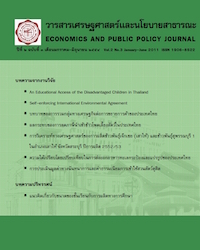An Educational Access of the Disadvantaged Children in Thailand
Main Article Content
บทคัดย่อ
The study finds determinants and analyzes the changes in school attending of the normal and disadvantaged children in the compulsory level since the 1999 NEA enforcement, using 1998 and 2006 SES. This study employs the logistic model (maximum likelihood function) to analyze the probability of school attending of the disadvantaged children in various age cohorts to overcome the self-select and biased estimates problem from unobservable variables. The results indicate that the determinants of school attending for the normal and disadvantaged children were characteristics of household heads and pupils such as sex and age, household size, location of household, parental status, parental education level, and particularly income of household. However, the impacts for the disadvantaged were more than the impacts for normal children. If the current monthly incomes per capita increase 10%, it pushes the probability of school attending increase 13% for normal children and 16% for disadvantaged children. Implementing NEA caused stronger income effects, and also encouraged the parents to support their disadvantaged children to attend school more. The findings also found that the academic level of household heads was the main factor encouraging the disadvantaged children to attend school. Furthermore, analysis of various age cohorts of disadvantaged children found that the younger cohort had more probability of school attending than the older cohort. This is probably because the opportunity cost of study is higher when the pupils are older.
Article Details
ประเภทบทความ
บทความวิจัย
สงวนลิขสิทธิ์ © 2553 คณะเศรษฐศาสตร์ มหาวิทยาลัยศรีนครินทรวิโรฒ
คณะเศรษฐศาสตร์ มหาวิทยาลัยศรีนครินทรวิโรฒ จัดพิมพ์วารสารเศรษฐศาสตร์และนโยบายสาธารณะ เพื่อเผยแพร่บทความวิชาการทางเศรษฐศาสตร์ นโยบายสารธารณะ และสาขาอื่นๆที่เกี่ยวข้อง ทัศนะและข้อคิดเห็นใดๆ ที่ปรากฏในวารสารเป็นความคิดเห็นส่วนตัวของผู้เขียน โดยบทความที่ได้รับการตอบรับจะถือเป็นลิขสิทธิ์ของคณะเศรษฐศาสตร์ มหาวิทยาลัยศรีนครินทรวิโรฒ
บรรณาธิการ อาจารย์ ดร.พลพัธน์ โคตรจรัส


